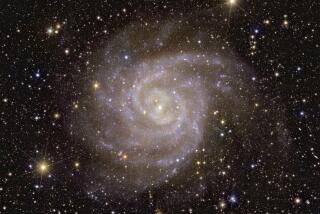Universe Ready for Its Close-Up
- Share via
A new camera installed in the Hubble Space Telescope in March is capturing images of some of the most distant features of the universe, said scientists who released the camera’s first snapshots Tuesday.
The camera “is a wider window, it’s a clearer window,” said Holland Ford, an astronomy professor at Johns Hopkins University who led the team that built the camera. “With this camera, we will get the deepest view of the universe that humanity has ever had.”
These pictures of colliding galaxies and swirling nebulas taken by the new Advanced Camera for Surveys each took about one day to shoot. In contrast, the Wide Field Planetary Camera 2, built at JPL and installed in 1993, took 10 days to make images of distant galaxies.
The Advanced Camera doubles the resolution and field of view of the Wide Field, which offered researchers a tiny, postage-stamp view of the sky, said deputy investigator Garth Illingworth, an astronomy professor at UC Santa Cruz. The new camera is also five times as sensitive.
The improved resolution allows scientists to see dim objects that have traveled farther away from Earth as the universe expanded, and are therefore older.
This is like getting information from what Ford calls the “twilight zone”--the time period just after the Big Bang that has gone unseen by current telescopes because the objects are too far away.
Ford estimates that scientists, using the new camera, will see as many stars and galaxies within the next year as were discovered in the entire 12 years of the Hubble’s existence.
Among the photos released Tuesday that particularly excited the researchers was a shot of the “Tadpole Galaxy,” located 420 million light-years away from our solar system in the constellation Draco.
But it is what lies behind the brilliant streak of stars streaming away from the spiral galaxy that really excited them.
About 3,000 dim, distant galaxies could be identified in the background of that image, some from within a billion years of the birth of the universe. Deep Field images of the same area showed only 1,500 galaxies.
Because it takes so long for light to travel such long distances, “we’re seeing [galaxies] when they were infants,” Ford said.
It would take a lot of squinting to find the celestial bodies in a newspaper photograph, however. Those images are too small. At a news conference in Washington, Ford and Illingworth used an 8-foot-by-8-foot enlargement to demonstrate their claims.
The Advanced Camera takes 16-million megapixels per shot, which means each image contains an enormous amount of information. The best digital cameras on the market today shoot about three to four megapixels.
Another image of two colliding galaxies called “The Mice” shows what could eventually happen to the Milky Way we call home.
As galaxies expand, they combine with those nearby. The two spiral galaxies exerted forces on each other and developed long mouse-like tails as a result.
Ford said the Milky Way, which contains our solar system, will interact with a galaxy in the constellation Andromeda in several billion years. Each will probably develop similar tails.





